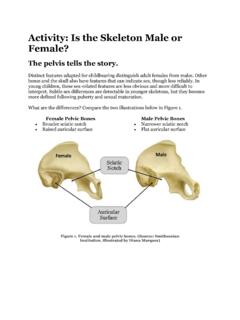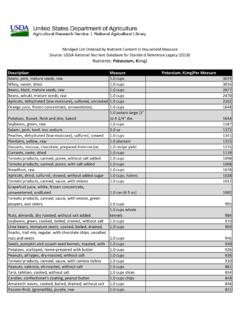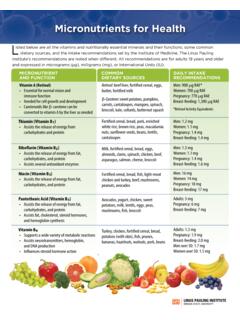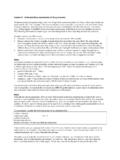Transcription of What did the Romans Eat, and Why? - National Museum of ...
1 , .. What did the Romans Eat, and Why? Madeline Brown, NHRE Intern, Summer 2010, in collaboration with Dr. Alain Touwaide Acknowledgements We would like to thank all of the Smithsonian staff members who have made this study possible as part of the NHRE Summer Intern Program. Special thanks to Cristi n Samper, Elizabeth Cottrell, Gene Hunt, and Virginia Power.
2 Summary The ancient Roman diet has been discussed and reconstructed in a number of previous studies, but none of them have attempted to fully quantify the nutritional and biological properties of the Roman diet. In this pilot study we combine literary, archaeological, and botanical data in order to uncover both the full list of plant and animal species likely eaten by the ancient Romans and how these specific foods contributed to the overall health of the Roman people. By combining modern Mediterranean dietary data with what we know about the consumption patterns of the ancient Romans , we quantified and reconstructed the nutritional properties of the ancient Roman diet. Based on our research, we suggest that the Roman diet relied heavily on cereals and legumes, which provided most of their caloric and nutritional needs.
3 Foods Mentioned in Classical Literature 0 100 200 300 400 500 Black Pepper Honey Barley Olive Coriander/Cilantro Fava Bean Myrtle Salt Mint Pomegranate Lupin, lupine Sheep Silphium Lettuce Turnip Horse Beet Basil Radish Sorb or service-apple Peach Cheese Einkorn Chickpea Caraway Sesame Cress Rocket, arugula Cinnamon Fenugreek Raspberry Cardoon Parsnip Elderberry Medlar Dog Dates Costus or putchuk Red Pea, Flatpod Peavine Jujube Marijuana, Hemp Arbutus, Strawberry Tree Pistachio Oyster Thrush Nitron Porcini Mediterranean gladiolus Pinna Garum Trigger-fish Pheasant Red Mullet Wild Radish Apricot Partridge Weever Beans Catnip, Catnip Grey mullet Scallop Alexanders, Maceron Mussels Golden chantarelle Carrot Fox Quail Watermelon Cake Goby Flamingo Gunard or piper Mackerel Sturgeon Weeping Norway Spruce Every ThirdFood Mentioned Number of Times Mentioned Caloric Value of Foods in Model Roman Diet Total food Vegetable oil Treenuts Fish, seafood Eggs Food Categories Percent of Daily RecommendedCaloric Intake (GDA)Low Wheat, Men High Wheat, Men Low Wheat, Women High Wheat, Women References 1) Andre, Jacques.
4 1981. L alimentation et la Cuisine a Rome Paris: Les Belles Lettres 2) Confederation of the food and drink industries of the EU (CIAA) Guideline Daily Amounts (GDAs) GDAs Explained. 3) Dalby, Andrew. 2003. Food in the Ancient World: From A to Z. London: Routledge 4) Food and Agriculture Organization of the United Nations (FAO) FAOSTAT Food Balance Sheets (Italy, Turkey, Greece, and Spain). #ancor. 5) USDA Agricultural Research Service Nutrient Data Laboratory USDA National Nutrient Database for Standard Reference 6) World Health Organization (WHO) and FAO 2004. vitamin and mineral requirements in human nutrition: Second edition. Nutritional Properties The high proportion of cereals and legumes in the ancient Roman diet provided them with a substantial amount of calories, protein, calcium , and iron.
5 While these foods are deficient in Vitamins A, C, and D, the Romans likely obtained these nutrients via seasonally available fruits and vegetables, though spices may also have played a role in providing these nutrients. Our analysis indicates that their diet was fairly low in vitamin D, sodium, and sugar. The ancient Roman people s high sun exposure and proximity to the sea also had positive health effects, conferring both vitamin D and iodine. Methods We evaluated the ancient Roman diet based on data from the FAO about the amount and proportions of foodstuffs annually consumed by contemporary Mediterranean people. Because the FAO divides diets into categories such as cereals, meats, and vegetable oil, we were able to estimate the relative amount of nutrients the ancient Romans would have gained from each food group by inserting foods from ancient diets rather than from modern ones into the appropriate categories.
6 In addition, since we know the ancient Romans probably consumed between 230 to 330 kg of cereals per year, we adjusted the amount of non-cereal foodstuffs in our model so that it provided the same total amount of food per year for both the high and low cereal consumption estimates. Primary Sources Our study relies on a review of both primary sources and secondary literature discussing the Roman diet, from which we drew a preliminary list of 321 different foods that were likely to have been consumed. Based on this survey, we found that ancient Roman authors mentioned some foods far more frequently than others. This information has been crucial for confirming the types of foods eaten by the ancient Romans .
7 Composition of Roman Diet Based on our knowledge of the types of foods eaten by the ancient Romans , we examined floras of Italy and archaeological evidence in order to determine which plant and animal species (both wild and domesticated) they likely ate. The Romans primarily ate cereals and legumes, usually with sides of vegetables, cheese, or meat and covered with sauces made out of fermented fish, vinegar, honey, and various herbs and spices. While they had some refrigeration, much of their diet depended on which foods were locally and seasonally available. Meat and fish were luxuries primarily reserved for the upper and upper middle classes. These results are reflected in the pyramids above.
8 Conclusions We found that the core constituents of the Roman diet (cereals and legumes) meet many of the daily nutritional needs of men and women when consumed in the amounts presumably eaten in ancient Rome. The Romans likely met their additional nutritional needs using a wide variety of more sporadically consumed foods such as meats, fruits, and spices. We also found that neither the nutritional properties nor the frequency of consumption for a given food seem to have been the determining factor for how often it was mentioned by classical authors. While we will probably not be able to know exactly what the ancient Romans ate, we should continue to attempt to quantify and better reconstruct the nutritional properties and composition of their diet through further investigations.
9 This initial study provides one model for introducing such quantification methods into research on ancient diets. Contributions by Food Type to Total Mass of Food Consumed in Model Roman Diet (High Wheat Estimate) Fish, seafood Eggs Cereals Vegetables & Starchy roots Vegetable oils Pulses Treenuts Oil crops Cereals Pulses Treenuts Oil crops Vegetable oils Vegetables & Starchy roots Spices Eggs Fish, seafood Contributions by Food Type to Total Mass of Food Consumed in Model Roman Diet (Low Wheat Estimate) Eggs Cereals Oil crops Vegetable oils Vegetables & Starchy roots Fish, seafood Pulses Cereals Pulses Treenuts Oil crops Vegetable oils Vegetables & Starchy roots Spices Eggs Fish, seafood This graph conveys the wide variation in the number of times various foods are mentioned in ancient Roman literature.
10 A comparatively small number of foods are mentioned far more often than the rest. Foods listed in classical Roman literature Relative Amount of Foods Eaten by the Ancient Romans Contact.





